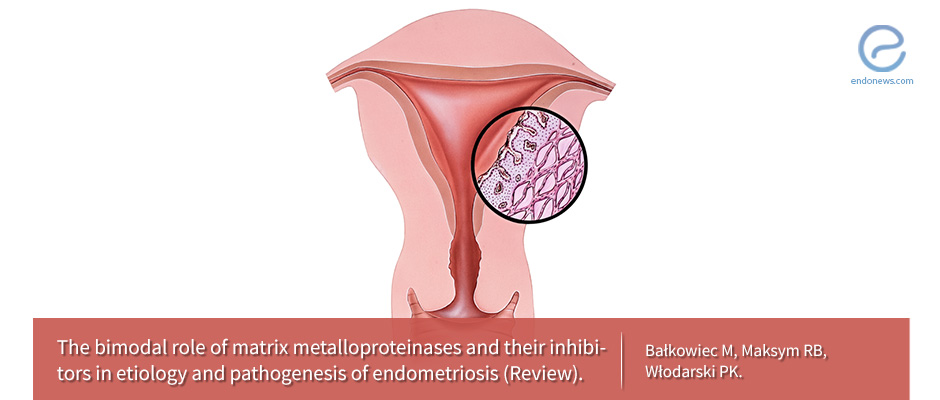A Balancing Act: How Endometriosis Invades the Body
Sep 4, 2018
Inhibitors and Activators of Matrix Metalloproteinases Play a Large Role in Endometriosis Progression
Key Points
Highlights:
- Aberrant regulation of matrix metalloproteinases (MMPs) may be a contributory factor in the formation of endometrial lesions.
Importance:
- Interactions between factors that act to alter the matrix turnover are crucial for the cyclic preparation of the endometrium for embryo implantation and endometrial shedding and renewal.
- Dysregulation of matrix remodeling has been implicated in the growth and invasion of ectopic endometrial tissue.
What’s done here?
- This article summarizes the current understanding of the endometrial cycle and extracellular matrix turnover in cases of endometriosis.
Data:
- Progestins, a mainstay of therapy for endometriosis-related pelvic pain, have been found to inhibit MMPs and enhance certain TIMP activity.
- Conversely, estrogens induce MMP-2 and MMP-9 expression.
- Interestingly, no difference was found in the menstrual effluent volume, and MMP-2 and MMP-9 levels in the menstrual blood of women with and without endometriosis.
Limitations:
- This is a review article highlighting previous research.
Lay Summary
Endometriosis is a disease defined by the presence of endometrial tissue outside of the uterine cavity. Ectopic endometrial tissues have been shown to have some features that mimic malignancy. For example, endometriosis can invade surrounding structures and attach to surfaces such as the ovary and peritoneum. This ability is thought to be linked to matrix metalloproteinases (MMPs), a group of enzymes that are involved in extracellular matrix and basement membrane breakdown and remodeling.
Several different MMPs have been classified depending on their specific activity including collagenases, gelatinases, stromelysins, and matrilysins. MMPs play an important role in bone remodeling, angiogenesis, inflammation, and cyclic changes of the endometrium. Conversely, enzymes that have been seen to inhibit MMP activity include "RECK" and a group of soluble tissue inhibitor of metalloproteinases (TIMPs). MMP activity has also been seen to be regulated by cytokines, growth factors, and hormones. Progestins, a mainstay of therapy for endometriosis-related pelvic pain, have been found to inhibit MMPs and enhance certain TIMP activity. Conversely, estrogen has been found to induce MMP-2 and MMP-9 expression.
Cytokines, molecules that are secreted by various inflammatory cells within sites of inflammation or cellular damage, have been implicated in the regulation of MMPs and TIMPs. IL-8 is one such cytokine seen to stimulate MMP-2 and MMP-9 expression in the endometrium. Another cytokine, IL-1α, enhances MMP-1 activity. Growth factors also play a role in this dynamic interaction between MMPs and TIMPs. Growth factors such as EGF and FGF increase various MMP expression. The peritoneal fluid has also been seen to have altered cytokine levels from patients with endometriosis. However, it remains undetermined whether the imbalance is a primary cause and not secondary to the presence of ectopic lesions. Studies that aimed to investigate serum MMP and TIMP activity as a potential biomarker found higher levels of MMP-2 and MMP-9 and lower levels of TIMP-1 in women with endometriosis. However, none of them was feasible enough to be a biomarker for clinical use.
While our understanding of the pathophysiology underlying endometriosis progression continues to expand, further research is needed to identify targeted therapies that shift the MMP‑TIMP balance to favor endometriosis regression and to prevent the occurrence of new lesions in symptomatic women with endometriosis.
Research Source: https://www.ncbi.nlm.nih.gov/pubmed/30066912
endometriosis metalloproteinases extracellular matrix progression invasion collagenase gelatinase stromelysin matrilysins remodeling angiogenesis inflammation RECK IL-1? IL-8

